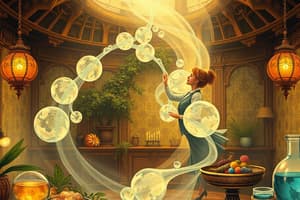Podcast
Questions and Answers
What is a chemical change?
What is a chemical change?
- A change that affects only the physical appearance.
- A change in their chemical properties or composition. (correct)
- A reversible change.
- A change that does not involve a chemical reaction.
What defines a physical change?
What defines a physical change?
- Changes affecting the form of a chemical substance. (correct)
- A reaction that produces gas.
- A change in chemical composition.
- A permanent change.
A change in texture is a physical change.
A change in texture is a physical change.
True (A)
A change in color is always a chemical change.
A change in color is always a chemical change.
A change in temperature is a physical change.
A change in temperature is a physical change.
What happens when water freezes?
What happens when water freezes?
Formation of bubbles is an indication of what type of change?
Formation of bubbles is an indication of what type of change?
What is an example of a substance undergoing a chemical change?
What is an example of a substance undergoing a chemical change?
What is a chemical reaction?
What is a chemical reaction?
Match the following terms with their definitions:
Match the following terms with their definitions:
Flashcards are hidden until you start studying
Study Notes
Chemical Change
- Involves a change in chemical properties or composition, forming new substances.
- Indicators of chemical change include the formation of bubbles, changes in odor, and energy release or absorption.
Physical Change
- Affects the form or appearance of a substance without altering its chemical composition.
- Examples include changes in texture, color, shape, and state (like solid to liquid).
Texture
- A change in texture is a physical change, maintaining the same chemical composition.
Color (Physical)
- Changing the color of an object, like painting a metal, is a physical change as it does not alter its chemical properties.
Temperature (Physical)
- Changes in temperature can affect a substance's form or appearance but not its chemical composition.
Shape
- Altering the shape of an object constitutes a physical change, leaving the chemical makeup unchanged.
State
- Changing the state of a substance, such as water freezing, is a physical change; the chemical identity (H2O) remains constant.
Formation of a Precipitate
- Occurs during a chemical change, indicated by a solid forming from a reaction, such as barium carbonate from a reaction with soluble carbonate.
Formation of Bubbles
- Bubbling often signifies a chemical change, indicating a reaction has occurred.
Fireworks
- The explosion of fireworks exemplifies a chemical change as it results from the reaction between different powders and fire.
Energy
- Involves either the release or absorption of energy, crucial for many chemical changes, such as cooking processes like baking.
Odor
- Changes in odor indicate a chemical change, e.g., food spoilage resulting in a distinct smell.
Chemical Reactions
- Chemical changes are referred to as chemical reactions, where substances combine to form new substances with distinct properties.
Color (Chemical)
- A change in color, such as a browning apple, signifies a chemical change, indicating spoilage.
Temperature (Chemical)
- Shifts in temperature during mixing of reactive substances point to a chemical change, leading to the formation of new products.
Metal Rusting
- The rusting of metal, while visible as a physical change, is a chemical reaction with oxygen that alters the metal's composition.
Studying That Suits You
Use AI to generate personalized quizzes and flashcards to suit your learning preferences.




